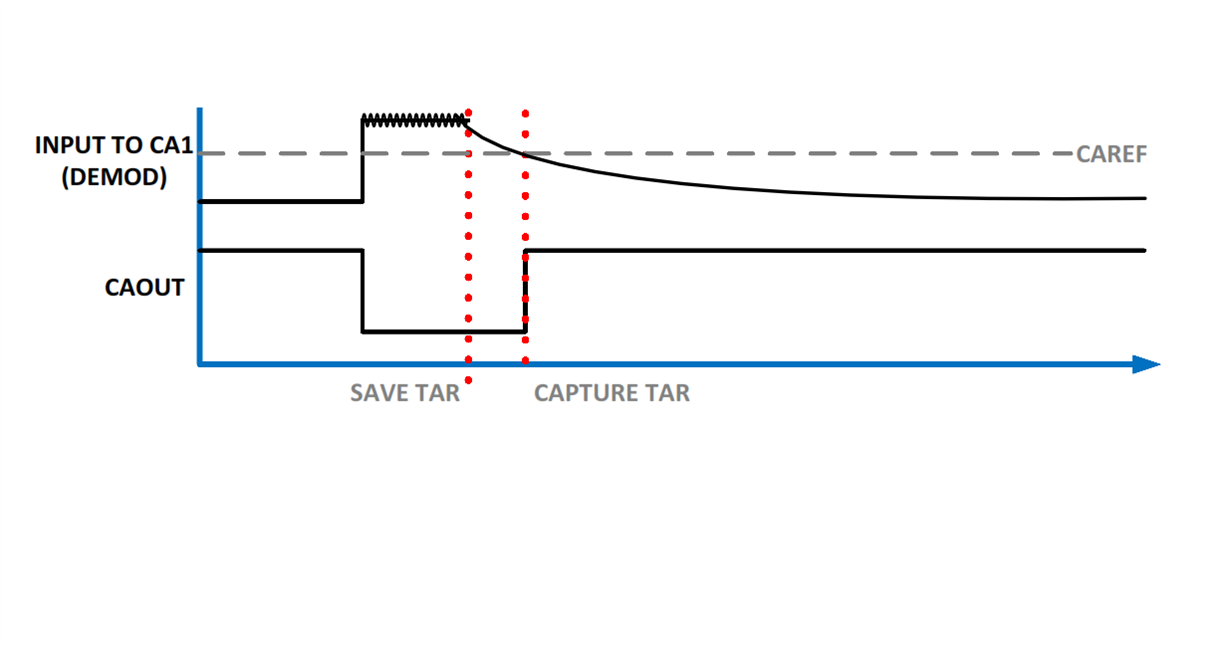Other Parts Discussed in Thread: MSP430F2370
Hi there,
I am trying to use tm41294NCPDT Internal analogue Comparator
I am trying to implement Low Power NFC/RFID Card detection Algorithm
what it does i charge the RC circuit which then discharges and through NFC antenna i read the voltage as soon as it goes down below threshold which in my case i am using 1.65 V (TEST CASE) comparator should generate interrupt
i want to generate following output from Comparator0 using C0+ pin
1:- but the problem is that it triggers interrupt at rising as well as falling edge moreover sometimes it generates interrupt once as soon as the interrupts are configured
2:- I was watching the registers during debugging in IAR and i noticed that instead of comparator 0 register comparator 1 registers are also updating(COMPACSTAT1) but i haven't configured comparator 1
3:- But my main priority is to generate the out put first as shown in figure then trigger an interrupt when comparator output goes back to 1 means interrupt on rising edge
Code is attached below :
Thanks
#include <stdbool.h>
#include <stdint.h>
#include "inc/hw_memmap.h"
#include "driverlib/gpio.h"
#include "driverlib/pin_map.h"
#include "driverlib/pwm.h"
#include "driverlib/sysctl.h"
#include "inc/hw_types.h"
#include "driverlib/debug.h"
#include "driverlib/adc.h"
#include "driverlib/interrupt.h"
#include "driverlib/comp.h"
#include <string.h>
#include "driverlib/uart.h"
#include "utils/uartstdio.h"
#include "driverlib/rom.h"
#include "inc/hw_ints.h"
#include "driverlib/rom_map.h"
uint32_t g_ui32SysClock=120000000;
#ifdef DEBUG
void
__error__(char *pcFilename, uint32_t ui32Line)
{
}
#endif
int x=0;
int status=0;
bool int_status=0;
bool int_status1=0;
int32_t Comp_out = 0;
void COMP_BASE_Interrupt(void)
{
int Comp_out;
Comp_out = ComparatorValueGet(COMP_BASE, 0);
// ComparatorIntClear(COMP_BASE,0);
//
// bool ulStatus;
// ulStatus =ComparatorIntStatus(COMP_BASE, 0, true);
ComparatorIntClear(COMP_BASE, 0);
// ComparatorIntDisable(COMP_BASE,0);
x++;
// if (status==0)
// {
// GPIOPinWrite(GPIO_PORTN_BASE, GPIO_PIN_0, 0x1);
// status=1;
// }
//
//
// if (status==1)
// {
// GPIOPinWrite(GPIO_PORTN_BASE, GPIO_PIN_0, 0x0);
// status=0;
// }
}
int main(void)
{
g_ui32SysClock= SysCtlClockFreqSet((SYSCTL_XTAL_25MHZ |
SYSCTL_OSC_MAIN |
SYSCTL_USE_PLL |
SYSCTL_CFG_VCO_480), 120000000);
int counter=20;
SysCtlPeripheralEnable(SYSCTL_PERIPH_GPIOF);
while ((!SysCtlPeripheralReady(SYSCTL_PERIPH_GPIOF))&&(counter==0))
{
counter--;
}
GPIOPinTypeGPIOOutput(GPIO_PORTF_BASE, GPIO_PIN_4 );
IntMasterDisable();
SysCtlPeripheralEnable(SYSCTL_PERIPH_GPIOC); //enable port C for negative input
int counter1=20;
while ((!SysCtlPeripheralReady(SYSCTL_PERIPH_GPIOC))&&(counter1==0))
{
counter1--;
}
SysCtlPeripheralEnable(SYSCTL_PERIPH_GPIOD); //enable port D For Output
int counter2=20;
while ((!SysCtlPeripheralReady(SYSCTL_PERIPH_GPIOD))&&(counter2==0))
{
counter2--;
}
GPIOPinTypeGPIOInput(GPIO_PORTC_BASE, GPIO_PIN_6 );
GPIOPinTypeGPIOOutput(GPIO_PORTD_BASE, GPIO_PIN_0 );
// GPIOPinWrite(GPIO_PORTD_BASE, GPIO_PIN_0,1);
// SysCtlDelay(100);
// GPIOPinWrite(GPIO_PORTD_BASE, GPIO_PIN_0,0);
SysCtlPeripheralEnable(SYSCTL_PERIPH_COMP0); // enable comparator 1
int counter3=20;
while ((!SysCtlPeripheralReady(SYSCTL_PERIPH_COMP0))&&(counter3==0))
{
counter3--;
}
// assign pin type
//GPIOPinTypeComparator(GPIO_PORTC_BASE, GPIO_PIN_7); //Analog comparator 1 negative input.
GPIOPinTypeComparator(GPIO_PORTC_BASE, GPIO_PIN_6); //Analog comparator 1 positive input.
//GPIOPinTypeComparator(GPIO_PORTD_BASE, GPIO_PIN_0); //Analog comparator 1 output.
//GPIOPinConfigure(GPIO_PIN_4); // pin configure
//GPIOPinConfigure(GPIO_PIN_5); //No Need because default function is analogue in
GPIOPinConfigure(GPIO_PD0_C0O);
ComparatorConfigure(COMP_BASE, 0, COMP_TRIG_NONE|COMP_ASRCP_REF
|COMP_INT_FALL | COMP_OUTPUT_NORMAL); // comparator configure
SysCtlDelay(100);
// set internal reference voltage
ComparatorRefSet(COMP_BASE, COMP_REF_1_65V );
//IntDisable(COMP_BASE);
ComparatorIntRegister(COMP_BASE,0, COMP_BASE_Interrupt);
ComparatorIntEnable(COMP_BASE,0);
//ComparatorIntRegister(COMP_BASE, INT_COMP0);
//IntEnable(INT_COMP0);
IntMasterEnable();
//SysCtlDelay(g_ui32SysClock / 96); // delay
;
while(1)
{
Comp_out = ComparatorValueGet(COMP_BASE, 0); // read comparator output
//
// int_status=ComparatorIntStatus(COMP_BASE, 0,true);
//
// if (Comp_out==0)
// {
// GPIOPinWrite(GPIO_PORTF_BASE, GPIO_PIN_0, 0x0);
// status=1;
// SysCtlDelay(1000000);
// }
//
//
// if (Comp_out==1)
// {
// GPIOPinWrite(GPIO_PORTF_BASE, GPIO_PIN_0, 0x1);
// status=0;
// SysCtlDelay(1000000);
// }
GPIOPinWrite(GPIO_PORTF_BASE, GPIO_PIN_0, 0x1);
SysCtlDelay(1000);
GPIOPinWrite(GPIO_PORTF_BASE, GPIO_PIN_0, 0x0);
SysCtlDelay(1000);
}
}


